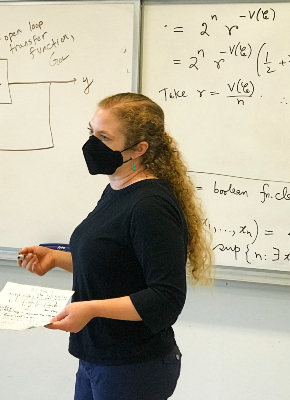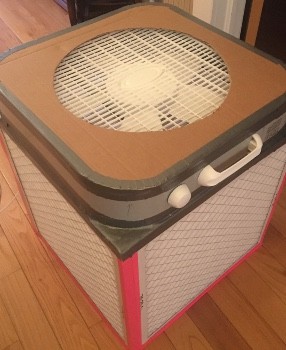Do HEPA Filters Really Catch Coronavirus Particles?
Aerosol scientist Faye McNeill explains air purifier basics, why masks really do work, and how chemistry experiments and computer simulations in the lab translate to environmental policy.

Faye McNeill is a chemical engineering professor at Columbia University who studies aerosols—microscopic particles suspended in air that include everything from dust to viruses to smog. Aerosols captured McNeill’s imagination as an undergrad at Caltech in the late 90s, a time when smog obscured the nearby San Gabriel Mountains for all but a handful of days each year. As her asthma worsened and her knowledge of atmospheric chemistry grew, McNeill came to appreciate the role of science in advancing public health and environmental policy.

At the molecular level, air pollution is anything but straight forward, she learned. Los Angeles had been trying since the 1940s to lower its ozone levels but it was more than a decade before scientists understood the cocktail of emissions that leads to smog. And decades longer before catalytic converters were added to vehicles to address the root of the problem. Smog forms when nitrogen oxides and volatile organic compounds in car exhaust and other emissions react with sunlight. “Reducing just NOx or VOCs alone may actually cause ozone to increase,” she said. “You need to control both NOx and VOCs to make ozone go down." Good policy depended on good science.
In her lab at Columbia Engineering, McNeill's group studies aerosol reactions at the molecular level, and runs multiscale computer simulations. Both studies are aimed at adding new knowledge to the U.S. Environmental Protection Agency’s models for testing proposed policies for improving air quality. In late 2019, she and a colleague, Daniel Westervelt, along with a large group of Columbia collaborators, launched the Clean Air Toolbox for Cities to help people in developing countries gather air pollution data. Their goal is to establish a baseline, track the pollution to its sources, and support local communities as they mobilize to improve air quality and public health.
Columbia News caught up with McNeill to talk about air filtration and best practices, and how the pandemic has changed her teaching and perspective on aerosols.
Q. What’s a HEPA filter and can it catch particles as small as a coronavirus?
A: HEPA is the international gold standard for filtering particles—it means that 99.97 percent of particles 0.3 microns in diameter are trapped. For context, a human hair is 50 microns across. The HEPA standard is more than 100 times smaller because it’s more difficult to trap particles that are smaller or bigger because of the physics of filtration. Masks and filters are not sieves, and snagging a virus is not like panning for gold. Particles either flow past or stick to the fibers in a filter based on their inertia or ability to diffuse toward the fiber.
So yes, HEPA filters can catch particles that contain coronaviruses. People expel droplets of respiratory fluid, saliva, and possibly viruses into the air when breathing, coughing, and talking. Even if the water in the droplet evaporates, the droplets contain salts, proteins, and other material in addition to any virus, which means the remaining particles are typically a few microns in size, making them fairly easy to trap with a HEPA filter.

Q. How important is the EPA’s 0.3 micron HEPA standard, then?
A. HEPA is the gold standard, but filters that aren't HEPA can still help remove particles from indoor air. A homemade air purifier called the “Corsi-Rosenthal Box,” consisting of an HVAC filter and a box fan, are quite effective.
Q. Where’s the best place to put an air purifier?
A. The best place is any room that needs more ventilation—an air purifier is backup support for a space with not enough air flow. I would not push it up against a wall or in a place where airflow is obstructed. Try to put it as close to the middle of the room as possible.
Q. Should you leave the air purifier on when you leave the room? What’s the best setting to use?
A. It depends on the room. If it’s a classroom with a 20-minute break between classes, leave it on, but turn it off at night. The setting depends on the size of the room and the fan’s capacity to pull air through. You should find the right size unit for the room.
Q. Do you use an air purifier at home? What should people look for?
A. Yes, but not for Covid reasons. I have asthma and so do my kids. We live in a dusty old NYC apartment, and the kids seem to breathe a little easier when I run an air purifier in their room. An air purifier consisting of a HEPA filter and fan are all you need. You don’t need ionizers, which create oxidants and particles. It’s counterproductive. If you’re mainly filtering for virus-containing particles, you don’t need PM 2.5 sensors. It’s an energy-saving feature that shuts down the purifier when levels of particles bigger than 2.5 microns in the air go below a certain threshold. But the level is mainly determined by dust and other particle sources, not respiratory aerosols. Go ahead and use the sensors if you’re filtering for pollutants, but you should run the purifier continuously if you’re after virus particles.
Q. How has Covid changed your perspective on particles?
A. I think a lot more about indoor air quality and the critical role of ventilation. It’s hard to believe all the things we used to do indoors without masks.
Q. You’re teaching a required class this fall for chemical engineering majors, “Chemical Process Control.” Do you wear a mask?
A. I teach to a packed classroom, so yes, I wear a mask—a KF94. I’m an aerosol scientist and I’m the person who’s projecting her voice and largely generating the most aerosols in the room. I also have two children at home who aren't fully vaccinated. I talked about it with my students on the first day of class and so far, haven’t found it to be difficult at all.